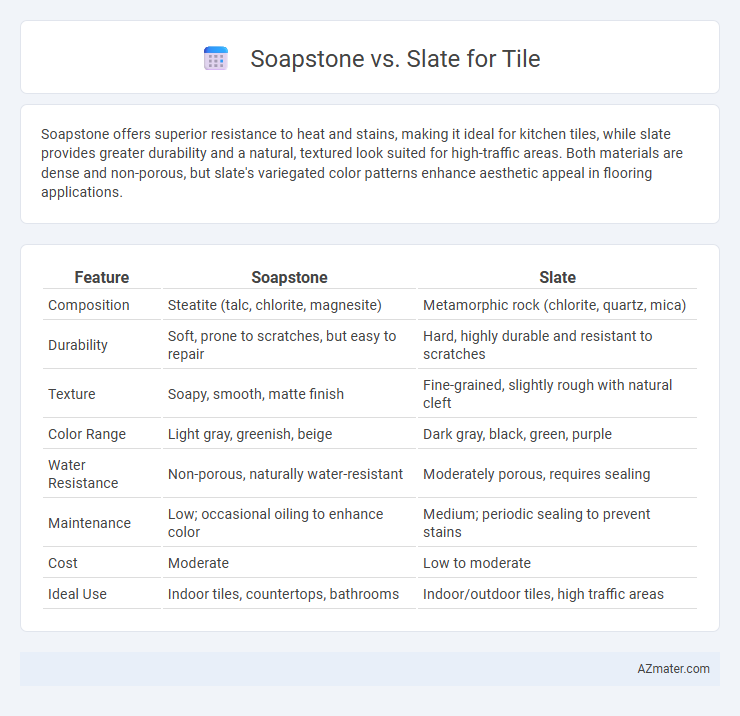Soapstone offers superior resistance to heat and stains, making it ideal for kitchen tiles, while slate provides greater durability and a natural, textured look suited for high-traffic areas. Both materials are dense and non-porous, but slate's variegated color patterns enhance aesthetic appeal in flooring applications.
Table of Comparison
| Feature | Soapstone | Slate |
|---|---|---|
| Composition | Steatite (talc, chlorite, magnesite) | Metamorphic rock (chlorite, quartz, mica) |
| Durability | Soft, prone to scratches, but easy to repair | Hard, highly durable and resistant to scratches |
| Texture | Soapy, smooth, matte finish | Fine-grained, slightly rough with natural cleft |
| Color Range | Light gray, greenish, beige | Dark gray, black, green, purple |
| Water Resistance | Non-porous, naturally water-resistant | Moderately porous, requires sealing |
| Maintenance | Low; occasional oiling to enhance color | Medium; periodic sealing to prevent stains |
| Cost | Moderate | Low to moderate |
| Ideal Use | Indoor tiles, countertops, bathrooms | Indoor/outdoor tiles, high traffic areas |
Introduction to Soapstone and Slate Tiles
Soapstone tiles are composed primarily of talc, making them soft, heat-resistant, and ideal for kitchens and bathrooms due to their non-porous, stain-resistant surface. Slate tiles, a metamorphic rock rich in quartz and mica, are durable and naturally slip-resistant, often used for flooring and wall cladding where moisture and durability are concerns. Both materials offer unique aesthetic textures and earthy tones but differ significantly in hardness, maintenance, and application suitability.
Key Differences Between Soapstone and Slate
Soapstone and slate differ significantly in composition and appearance; soapstone is a metamorphic rock rich in talc, giving it a soft, smooth texture, while slate is a fine-grained foliated metamorphic rock known for its durability and natural cleft surface. Soapstone tiles offer excellent heat resistance and non-porous qualities, making them ideal for kitchens and bathrooms, whereas slate tiles provide superior hardness and water resistance, suitable for high-traffic areas and outdoor use. Color variations also distinguish the two, as soapstone typically exhibits bluish-gray hues with subtle veining, while slate ranges widely from gray to green, purple, and even rusty tones.
Appearance and Color Variations
Soapstone offers a smooth, matte finish with soft, natural veining that ranges from gray to greenish-black tones, creating a warm, organic look ideal for rustic or traditional interiors. Slate provides a more textured surface with a broader color palette, including shades of gray, blue, green, and purple, lending a dynamic and varied appearance suited for contemporary or eclectic designs. Both materials enhance tile applications with unique visual depth, but soapstone's subtle elegance contrasts with slate's vivid diversity, catering to different aesthetic preferences.
Durability and Strength Comparison
Soapstone tiles offer excellent durability with high resistance to heat, stains, and scratches due to their dense, non-porous structure, making them ideal for high-traffic areas. Slate tiles provide superior strength and impact resistance thanks to their natural layered formation, which enhances their ability to withstand heavy use and pressure without cracking. Both materials exhibit robust longevity, but slate's higher hardness rating on the Mohs scale often results in greater overall structural strength compared to soapstone.
Water Resistance and Porosity
Soapstone offers superior water resistance compared to slate due to its non-porous nature, making it less prone to staining and moisture damage. Slate tiles have higher porosity, requiring regular sealing to prevent water absorption and potential deterioration over time. The low porosity of soapstone ensures better durability in wet environments, ideal for bathrooms and kitchens.
Maintenance and Cleaning Requirements
Soapstone tiles require minimal maintenance due to their non-porous nature, resisting stains and moisture without the need for sealants, and they can be cleaned effectively with mild soap and water. Slate tiles, being more porous, demand regular sealing to prevent staining and water damage, and they benefit from gentle cleaning agents to avoid surface degradation. Both materials offer durability, but soapstone's ease of upkeep makes it a preferred choice for low-maintenance tile installations.
Cost Comparison of Soapstone vs Slate Tiles
Soapstone tiles generally cost between $10 and $25 per square foot, making them a moderately priced natural stone option with excellent durability and heat resistance. Slate tiles typically range from $4 to $10 per square foot, offering a more budget-friendly alternative while still providing strong scratch and moisture resistance. Installation expenses for both materials depend on tile size and labor rates but tend to be higher for soapstone due to its density and weight, which require specialized handling.
Installation Process and Considerations
Soapstone tiles offer easier installation due to their softness, allowing simpler cutting and shaping with standard tools compared to slate. Slate requires more careful handling and professional tools because of its natural cleft surface and brittleness, increasing installation time and complexity. Both materials need proper sealing, but slate often demands more frequent maintenance to prevent moisture penetration and staining.
Environmental Impact and Sustainability
Soapstone and slate both offer environmentally friendly options for tile due to their natural composition and durability. Soapstone is highly sustainable because it requires minimal processing and produces less quarry waste, while slate's extraction and finishing involve more energy-intensive practices, impacting its carbon footprint. Choosing soapstone tile supports reduced environmental impact through its longevity and less intensive manufacturing compared to slate, making it an eco-conscious option for sustainable building projects.
Best Applications: Choosing the Right Tile for Your Project
Soapstone tile excels in kitchen countertops and bathroom surfaces due to its heat resistance, non-porous nature, and smooth, matte finish that resists stains and bacteria. Slate tile is ideal for high-traffic flooring and outdoor patios, as its natural cleft surface provides excellent slip resistance and durability against weathering. Selecting soapstone for indoor applications benefits warmth and ease of maintenance, while slate's rugged texture suits exterior settings and rustic interiors.

Infographic: Soapstone vs Slate for Tile
 azmater.com
azmater.com